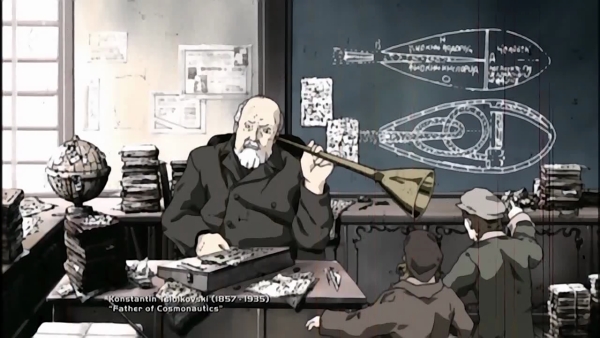

 Konstantin Tsiolkovsky: Pioneer in Space TravelKonstantin Tsiolkovsky (1857-1935) is well known in Russia as the father of cosmonautics and rocket dynamics. While his name is not as familiar in the United States, Tsiolkovsky’s work was extensively studied in the 1950’s and 1960’s as Americans attempted to understand the early success of the Soviet Union’s space program. Although Tsiolkovsky was born more than one hundred years before Sputnik became the first object launched into space, he prepared the way for it and all future space exploration. Tsiolkovsky was a true visionary who theorized many aspects of space travel and rocket propulsion decades ahead of others. Tsiolkovsky also imagined satellites and space stations long before such ideas could actually be implemented. Konstantin Eduardovich Tsiolkovsky was born on September 17, 1857 in the village of Izhevskoye, Russia. He lived at the time of Tchaikovsky and Tolstoy. Konstantin was the fifth out of 18 brothers and sisters! Although his father was a Polish noble by birth, after immigrating to Russia he ended up working a regular job as a forestry official, but nevertheless was a good provider for the family. Tsiolkovsky was entirely self-educated. “Besides books I had no other teachers,” he later wrote. A disability kept him out of school and jump-started his lifelong drive for self-directed learning. “At the age of 10 he lost his hearing as the result of scarlet fever. After that he couldn’t attend school, and he never received any formal education. The knowledge and education he attained were achieved by himself. His books were his teachers, and he read every book in his father's library.” [1] By age 14, Konstantin was studying natural science, physics, and mathematics. In 1873, when he was 16, Tsiolkovsky’s father sent him to further his studies in Moscow which held the country’s finest libraries. For the next few years, Konstantin chose to live on black bread while saving his meager allowance for books and scientific supplies. He studied mathematics, mechanics, astronomy, physics, chemistry, classical literature, and philosophy. “During this time…Tsiolkovsky was tutored by the eccentric and brilliant Russian philosopher Nikolai Fedorovitch Fedorov, who was working in a Moscow library at the time. Fedorov was a leading proponent of Russian Cosmism, and gave Tsiolkovsky a place to work in the library. In many ways, he took the place of the university lecturers that Tsiolkovsky never had access to.” [2] Later, Tsiolkovsky invented an ear trumpet – a conical acoustic device used as a hearing aid – so that he could attend academic lectures. Having first dreamed about the possibility of space flight as a boy, Tsiolkovsky became enthralled with the idea of interplanetary travel by the time he turned 17. Inspired by Jules Verne’s stories – particularly From the Earth to the Moon – Konstantin tried his own hand at speculative science fiction and futuristic scenarios while seriously considering the practicality of Verne’s ideas. Tsiolkovsky started to think more realistically about space-related matters including the technical problems of space vehicle design, the feasibility of living in outer space, and the effects that weightlessness would have on humans. Tsiolkovsky returned home in 1876, where he became a private tutor in physics and mathematics. Because of his proficiency in math and science, Tsiolkovsky was able to pass an exam to become a teacher despite his lack of formal education. At the age of 21, he took a job as a teacher of arithmetic, geometry, and physics at a school in Borovsk. Far from any scientific centers, he developed a passion for invention and gained a reputation as the village genius. He built a workshop where in his spare time he designed and tested all kinds of contraptions including kites, hot air balloons, and even a mechanical vulture. His first known scientific work, “Astronomical Drawings,” was published in 1879. It reflected his early interest in space by schematically depicting the solar system and the distances between planets. In August 1880, Tsiolkovsky married Varvara (Barbara) Sokolova, the daughter of a preacher. They had three daughters and four sons. In 1892, Tsiolkovsky received a teaching promotion and the family moved to Kaluga in western Russia. He taught arithmetic and geometry at the local school for the next 30 years. It was here that he studied all types of flight, both in and out of the atmosphere, and this is where Tsiolkovsky wrote and published his theories of space flight and interplanetary travel. At first Tsiolkovsky concentrated on the design, construction, mathematics and mechanics of heavier-than-air flying machines. In 1886 he invented a corrugated metal dirigible that had advanced features not found in Count Zeppelin’s invention of 1900. Tsiolkovsky designed a single-wing airplane in 1894 that was supposedly better than the biplane flown by the Wright brothers in 1903. He gained status as a scientist when the Society of Physics and Chemistry, impressed by Tsiolkovsky’s intellectual independence, elected him as a member. In 1897 Tsiolkovsky built the first wind tunnel in Russia. He used it to conduct research in aerodynamics, studying the effects of air friction and surface area on the speed of the air current over a streamlined body. The results of these pioneering experiments in aeronautical engineering were published the following year. The Academy of Sciences in St. Petersburg gave him a financial grant to build a larger wind tunnel and expand his research in this field. Tsiolkovsky then compared the feasibility of dirigibles and airplanes, which led him to develop advanced aircraft designs. After mastering the art of aerodynamics and aircraft, Tsiolkovsky began to devote more attention to the more ambitious subject of rocketry and space flight. He realized that, unlike aircraft, spacecraft would need a special type of engine that could work in the vacuum of space. Tsiolkovsky was the first to work out the theoretical laws of motion for objects in space. He built a centrifuge to simulate different levels of gravity and test their effects. Tsiolkovsky experimented with the properties of gases and developed the specifications for rocket engine design. His “Tsiolkovsky Formula” established the fundamental relationship in which a vehicle’s maximum velocity can be expressed as a function of its mass and the speed of its exhaust gases. Then followed a series of increasingly sophisticated hypotheses and calculations on the technical aspects of space flight: gyroscopic stabilization, the effects of air drag on rocket motion, escape velocities from the earth’s gravitational field, the principle of reactive action, the use of liquid-fuel propellants for rockets, and the use of multistage rockets (which he called “Space Rocket Trains”). Thus, as early as the turn of the 20th century, Tsiolkovsky was confident that interplanetary exploration was possible by means of rocket propulsion. Modern rockets still incorporate many of his basic ideas. After Tsiolkovsky retired from teaching, he continued to write on space and aeronautics. In the 1920’s and 1930’s Tsiolkovsky proved especially productive, publishing ten major works, elucidating the nature of bodies in orbit, developing scientific principles behind reaction vehicles, designing orbital space stations, and promoting interplanetary travel. He also furthered studies on many principles commonly used in rockets today: specific impulse to gauge engine performance, multistage boosters, fuel mixtures such as liquid hydrogen and liquid oxygen, the problems and possibilities inherent in microgravity, the promise of solar power, and spacesuits for extra-vehicular activity. Altogether, Tsiolkovsky wrote over 500 papers on astronautics, astronomy, mechanics, physics and philosophy. Unfortunately, Tsiolkovsky never had the resources to build any practical models for testing his rocket theories, and due to Russian political instability his innovative designs went unnoticed. In addition, Tsiolkovsky’s rocket designs were little known outside Imperial Russia. Decades later, German scientists independently made the same calculations that Tsiolkovsky had already done. Nevertheless, Tsiolkovsky’s writings endured and eventually served as the foundation for Russia’s rocket and space program. Even though he never created any rockets himself, he influenced the younger generation of Russian engineers and scientists who began to make his visionary concepts a reality. After the Bolshevik revolution of 1917 and the creation of the Soviet Union, Tsiolkovsky was formally recognized for his accomplishments in the theory of space flight. With the advent of Soviet power in Russia, Tsiolkovsky's work received the full support of the state. In 1919 he was elected to the Socialist Academy of Science. On November 9, 1921, the council of the People’s Commissars granted him a pension for life in recognition of his services in education and aviation. This allowed him to retire from teaching at the age of sixty-four. Thereafter he devoted full time to developing his space flight theories. Although Robert Goddard launched the first liquid-fueled rocket in the United States in 1926 and Hermann Oberth soon followed in Germany, the Russians did not get a rocket off the ground until Tsiolkovsky was too old and ill to travel to see it. Upon the publication of the works of German rocket pioneer Herman Oberth in 1923, Tsiolkovsky's works were revised and published more widely, and he finally earned some international recognition for his ideas. Thus, Tsiolkovsky inspired leading Soviet rocket engineers such as Sergey Korolyov, who would become the chief designer of the Soviet space program. Following an operation for stomach cancer, Tsiolkovsky died on September 19, 1935. Although largely ignored during his lifetime, Tsiolkovsky’s work was finally recognized as the space age got underway. His home in Kaluga was made into a museum. Following the orbiting of Sputnik 1, the world’s first satellite, the Tsiolkovsky Museum became a popular attraction. The launch of Sputnik 1 was intended to coincide with the 100th anniversary of Tsiolkovsky’s birth, a special stamp was issued for the occasion, and September 17, 1957, was marked by speeches honoring the rocket pioneer in Kaluga and Moscow. However, the launch was delayed until October 4. In 1959 when the Soviet Luna 3 took the first photographs of the far side of the moon, the largest crater was named after him. Tsiolkovsky Crater can’t be seen from earth and only rocket-powered spaceships can reach it. Tsiolkovsky’s ultimate goal was for humans to eventually colonize outer space. He believed that beginning with artificial earth satellites (sputniks), interplanetary stations and flights to the planets could eventually become a way of establishing communities in outer space and adapting space for human needs. The Japanese anime "Planetes," an award-winning futuristic science fiction story, pays tribute to Tsiolkovsky in its opening scene (see picture above) and in a later episode. The creators of "Planetes" took special care to show a realistic depiction of space and space travel. Tsiolkovsky's most famous quote is, "Earth is the cradle of humanity, but one cannot remain in the cradle forever." Konstantin E. Tsiolkovsky’s 16 Stages of Space Exploration (1926)
1. Design of rocket-propelled airplanes with wings. References http://www.informatics.org/museum/ (Konstantin E. Tsiolkovsky State Museum of the History of Cosmonautics) http://www.russianspaceweb.com/tsiolkovsky_bio.html (Konstantin Tsiolkovsky Biography. Russian Space Web.) http://www.hq.nasa.gov/office/pao/History/sputnik/kon.html (Sputnik Biographies: Konstantin E. Tsiolkovsky. NASA Headquarters.)
Contact: . Thanks! Please click here for reprint permission.


These pages are a continuous work in progress.
|
Help Support this Site
and purchase items via our affiliate links. Thank you!
 
Thank you for visiting my |

